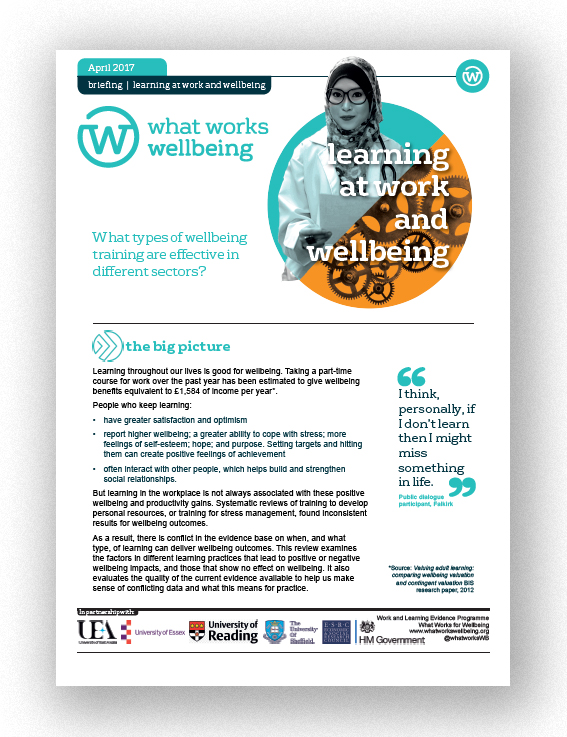
Download the Learning at Work briefing
What does the new briefing on learning at work tell us about how we best develop and learn in our workplace, whether it’s an office, hospital ward, factory or anywhere else?
The main message from the research, which looked at 41 studies, is that wellbeing training works, at least in the short-term. And if you’re torn between getting in a mindfulness trainer or Cognitive Behavioural Therapist, or any of the other 15 wellbeing courses listed in our briefing for your work, the evidence shows that they all have a positive impact.
What’s more, even professional development training, which doesn’t explicitly focus on wellbeing as an outcome, could have wellbeing benefits. This is especially the case where professional skills overlap with wellbeing skills. For example, conflict management training for healthcare workers to help them deal with challenging situations with patients was also effective in reducing conflict with colleagues, improving staff wellbeing and performance (Watson et al., 2017; Leon-Perez et al., 2016). The evidence base needs to be developed here, because much of it comes from the health sector, but findings indicate there are no adverse effects.
What did seem to affect the impact of workplace learning was whether the training – regardless of whether it’s wellbeing, professional or leadership – had interactive elements. This could include dialogue with a learning facilitator, or peer-to peer learning such as group reflection or discussion. Each of the successful online trainings incorporated these kinds of social elements to the learning process alongside online delivery. Self-directed e-learning alone was found to be less effective at improving wellbeing. Although, again, we need to to see more evidence for this finding: since the original studies our review draws its evidence from were carried out, there have undoubtedly been advances in technology and how e-learning can be delivered.
This chimes with the broader evidence base on learning and wellbeing, which tells us that the opportunity to reflect, share experiences, learn from others are vital adult learning principles, beyond the educational outcomes.
There’s a caveat to the review: much of the evidence focuses on job roles that place a high demand on social relationships in service delivery, such as carer, health, education or sales roles. We need to build the evidence base for job roles where social relationships, while important, may not be the primary focus, for example in the technology or creative industries.
And then we come to the other main takeaway from the briefing: training employees to cope better is not the end of the story. Wellbeing is highly dependent on job quality: the tasks which staff do day-to-day and their experiences on the job. This includes our relationships with our colleagues or clients, and the ability to influence workload and decisions.
Employers need to make sure any wellbeing training is part of a larger programme of improving job quality. And we’ll be publishing a new briefing on what works to improve job quality later this month.
